|
Tapas Das
Building a studio around a Korg i30
Click here for the entire text...
|
The 16 JPEG images portray the equipment
in the 3 rooms set up for home studio use.
1. Recording Room
2. Playback Room
3. Research and Study Room
|
1. Recording Room
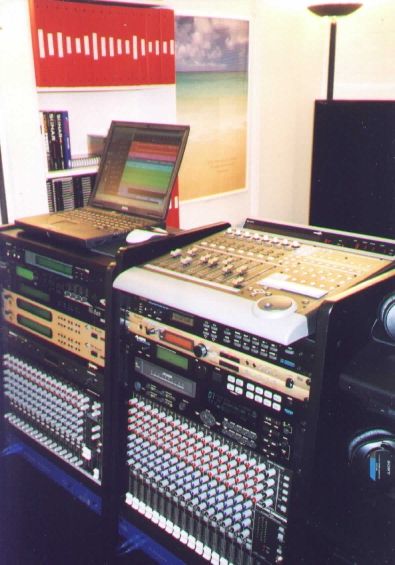
MIDI Sequencing is performed with Emagic Logic Audio Platinum
v.5.3 running on a DELL Inspiron 4100 laptop PC with a 1GHz Pentium III processor, 256MB of RAM, 30GB HD, and Win98SE.
A Logitech ColorSelect Cordless Mouse sits next to the laptop.
The Sound Modules, Mixers and effect processors are housed in
the two OmniRAX Pro20 units. A Logic Control sporting nine 100mm touch sensitive optical Penny+Giles faders sits on top of
the right rack.
The Logic Control is used to write track automation. A couple
of Sony MDR-7506 headphones are used to detect and correct anomalies in the individual tracks.
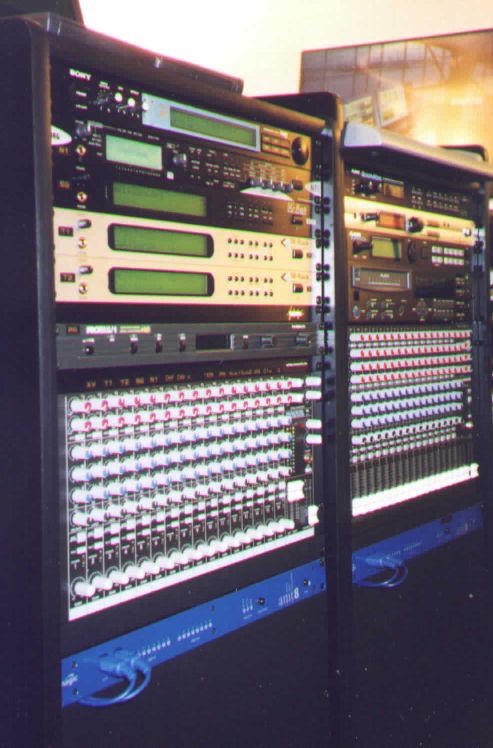
Above: A Sony DPS-R7 Professional Reverb, housed
in the top space of the left rack, is applied to smoothen out the final mix. Below that there is a Korg N1R GM/GS/XG playback
module. A Korg SG-Rack below this is used for all Piano and Electric Piano sounds.
The two Korg TR-Racks are used mainly for Bells,
Organs, Shimmering Strings and Airy Pads. The EMU Proteus-1 module with the Protologic Expansion board below the TR-Racks
are used for general bread and butter sounds. The
Mackie LM3204, 32 channel mixer acts as an audio patch bay for the synths and sound modules. The main volumes on the synths
and sound modules are set to Maximum, while the channel gains on the LM3204 are set to Unity. All track volumes are controlled,
recorded and set via the Logic Control. At the
bottom of the left rack sits the Emagic AMT8 8in/8out MIDI interface.
On the top space of the right rack sits an Alesis
Quadraverb followed by a Roland XV-5050 64 voice Sound Module which is used for Acoustic Guitars and Brass sounds. An Alesis
DM5 dedicated drum module provides the drum and percussion sounds. All the synth patches are programmed and tweaked using
Emagic SoundDiver v.3.0.4.
All the synths and sound modules are played live
via the MIDI sequences and recorded off the main stereo out of the Mackie LM3204 mixer directly into the Alesis Masterlink
ML-9600 hard disk recorder at 24 bits/96KHz and later dithered down to 16-bits/44.1KHz to make a standard Red Book audio CD.
A Mackie CR1604 16 channel mixer sits under the Masterlink
followed by a second Emagic AMT8 8in/8out MIDI interface. The two AMT8 units are connected in series to the DELL laptop via
USB to create a 16in/16out 512 channel MIDI interface for networking all the synths and sound modules. An APC BK650MC
battery backup hides behind the rack to power the laptop in case of a power failure.
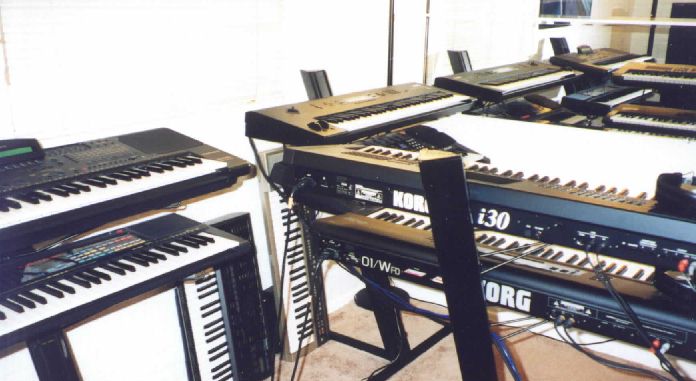
The Korg i30 serves as the Master Controller Keyboard. Backing
sequences with the correct chord progressions and fill-ins using the appropriate styles are first created for each song on
the i30 and then these MIDI sequences are transfered to Emagic Logic for further editing, revoicing and polishing. Logic is
then used to play back the backing tracks utilizing the patches on the external sound modules while the lead parts are played
live on the Korg i30 and Korg O1/Wfd acting like a dual manual synth.
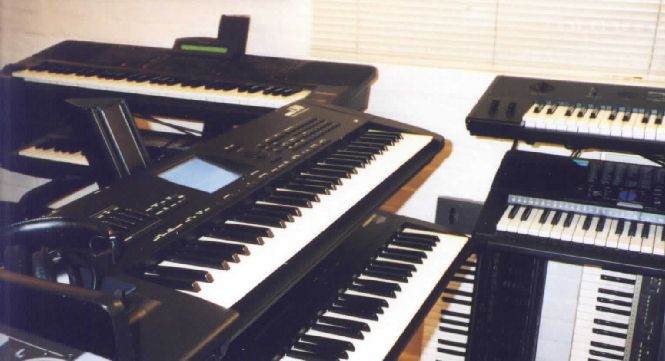
The sounds of the Korg Wavestation EX keyboard is used to layer the
O1/W sounds to create unique evolving textures. The Technics KN1000 keyboard is sometimes used to create quick composer patterns,
while the Casio CTK-620K keyboard is used to analyze and monitor MIDI channels thanks to its lighted keys.
The combined output of this MIDI rig offers:
512 MIDI Channels
480
Note Polyphony
4850 Programs
2004 Combinations/Performances
796 Digital Effects, 39 of which can be used simultaneously.
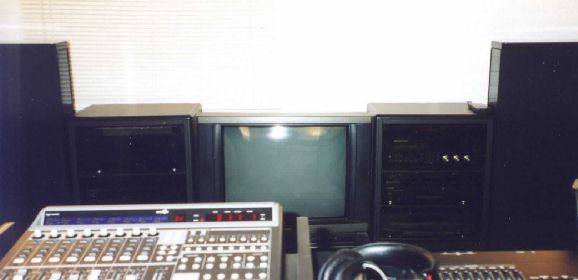
A pair of Mirage M-3si floor standing bipolar speakers are used
for mid-field monitoring. They are powered by an Adcom GFA-555 power amp sitting below the Toshiba 27" direct view CRT
TV. The MIDI volumes and pan settings for each track is fine tuned via Logic Control.
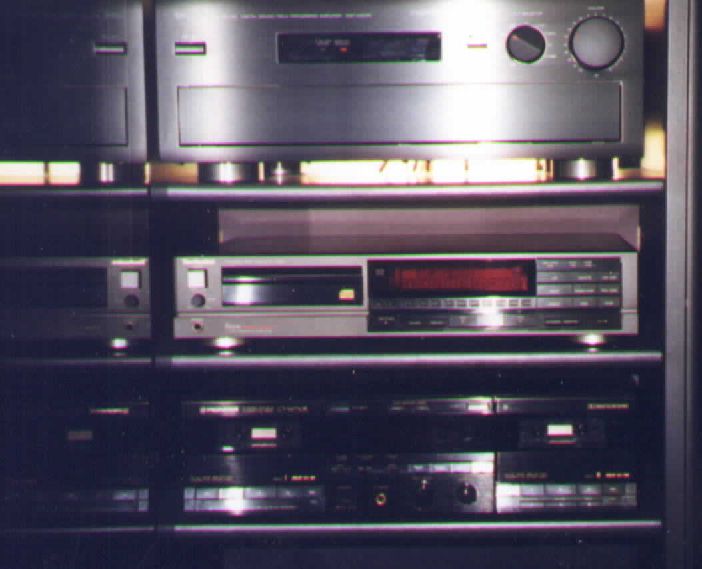
The left cabinet holds the Yamaha DSP-A2070 7 channel preamp/processor
followed by a Technics CD player and Pioneer dual cassette player.
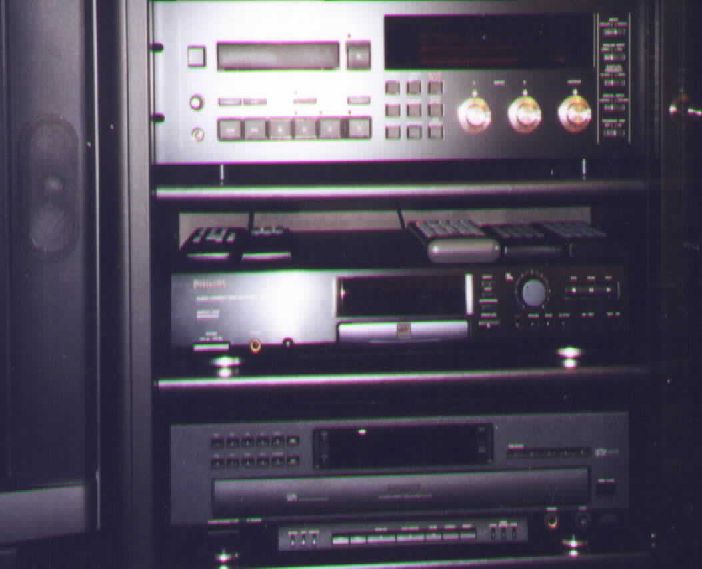
The right cabinet houses the Tascam DA-30 DAT recorder, a Philips
CDR880 CD recorder and a Philips CDC-936 5 CD changer.
2. Playback Room
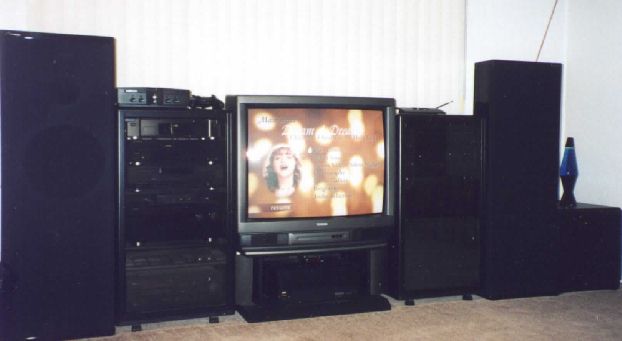
The Playback Room is setup for 7 channel Dolby Digital/DTS surround
sound with a second pair of Mirage M-3si bipolar speakers driven by another Adcom GFA-555 250W/Ch power amp sitting under
the Toshiba 36" direct view CRT TV. The sub bass is reinforced by a Paradigm Servo-15 servo controlled 15" woofer with
its own 400W amp. A pair of Rock Solids mounted high on the ceiling work as front effect speakers while a pair of floor standing
RSL speakers work for rear effects.
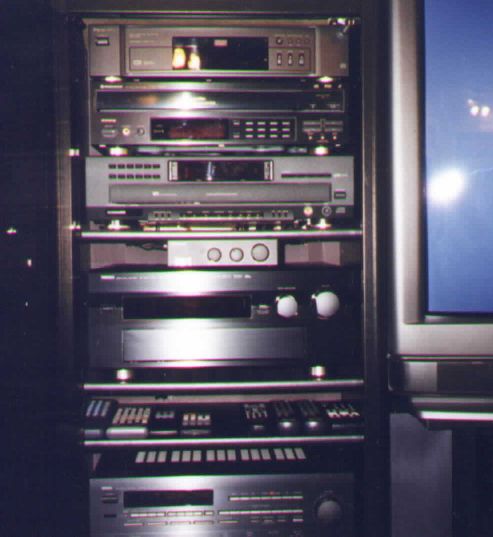
The left stereo rack holds a Panasonic DVD player, a Pioneer
Laser Disc player and a Philips CD changer. Below that sits the Yamaha DSP-A1 seven channel preamp/processor offering a multitude
of customizable surround sound modes. The bottom rack is occupied by a Yamaha RXV-870 receiver.
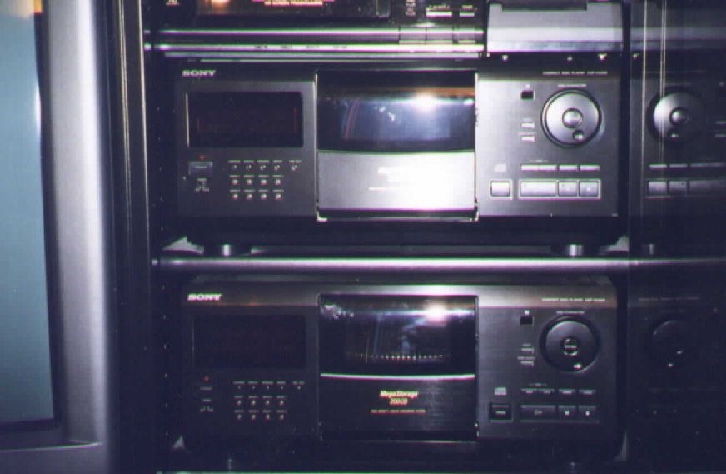
The right stereo rack holds a couple of Sony CDP CX250 mega
changers and a HiFi VCR. The mega changers allow a total of 400 CDs to be on-line and ready for playback in random, by
group, program or repeat modes.
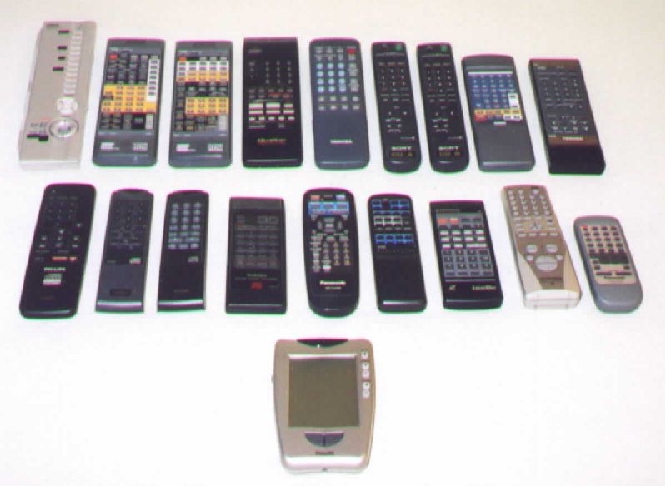
A single Philips Proto TSU2000 programmable remote replaces
the 18 individual instrument remotes. Any track amongst the 400 CDs can be selected by Artist or Title by a clever menu
system on the Pronto's touch screen. The entire show including lighting is controlled with the TSU2000.
3. Research and Study Room
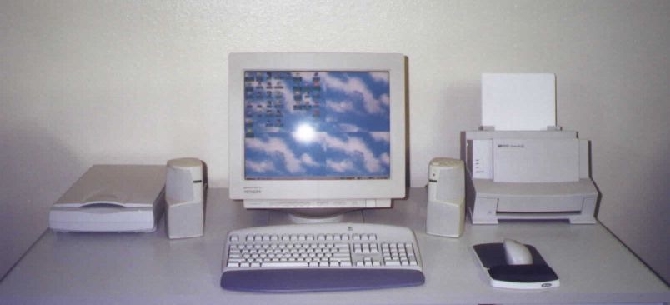
A Dell Desktop PC is used in the Research & Study Room for
all non-music related work like Internet surfing and research. The desk has an uncluttered look thanks to a Logitech Cordless
keyboard and Mouse. A pair of Altec Lansing speakers flank the Hitachi SuperScan Elite 751 19" monitor. The subwoofer
hides below the desk. Scanning and Laser printing is done on the Visioneer Paperport 3100 and HP Laserjet 6L.
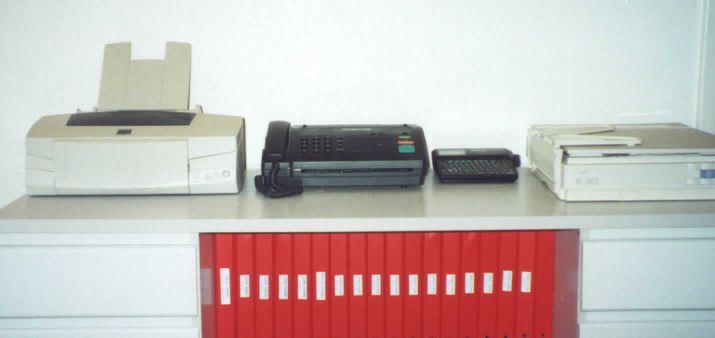
The Epson Stylus Photo 700 color inkjet prints high quality glossy
CD labels using CD Stomper Pro. Sitting next to it is a Sharp FAX machine, a Casio KL-8200 label maker and a Canon PC310 personal
copier.
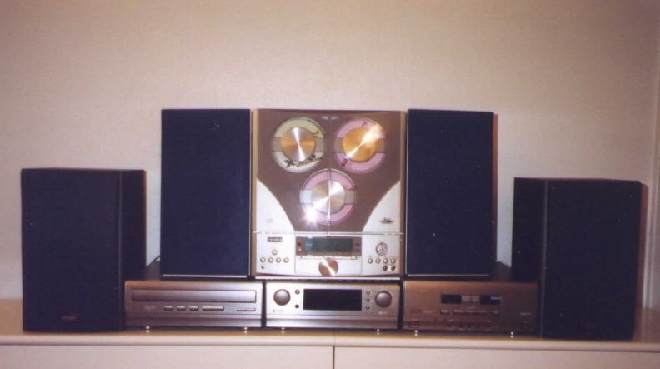
CDs made on the Masterlink in the Recording Room is first tested
in the Playback Room under various sound fields and then tested on a Yamaha table top unit and a Fisher Wall mountable stereo.
A good mix should be able to hold up under lesser speakers.
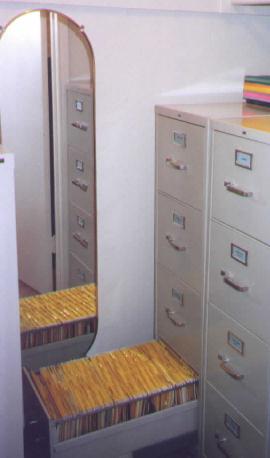
All the information gathered from trade shows, product brochures,
spec sheets, price lists are carefully alphabetized, placed in yellow hanging folders, and filed for quick reference. By accounting
for every piece of paper, junk is never allowed to accumulate.
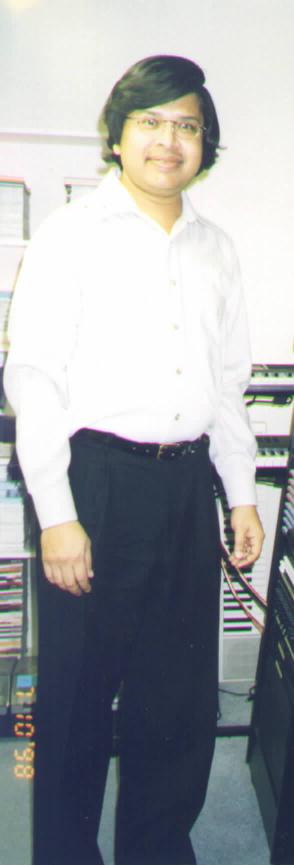
Tapas Das
|